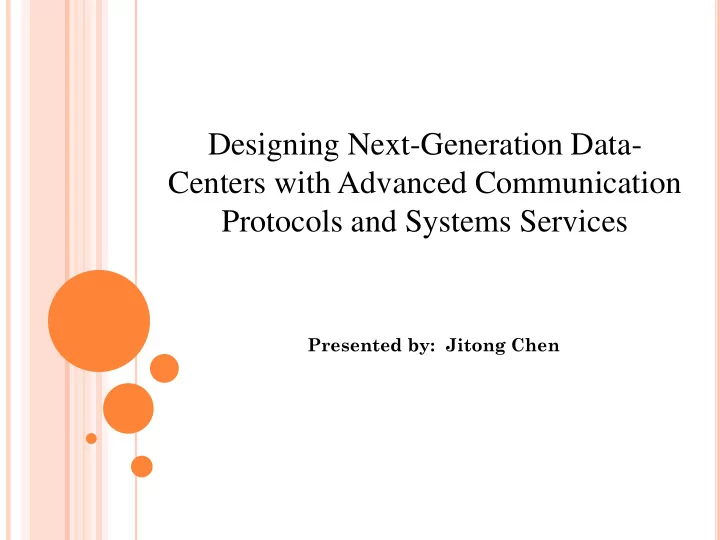

Designing Next-Generation Data- Centers with Advanced Communication Protocols and Systems Services Presented by: Jitong Chen
Outline Architecture of Web-based Data Center Three-Stage framework to benefit from InfiniBand Optimize Communication Protocol Data-Center Service Primitives Dynamic Content Caching Active Resource Adaptation
Architecture of Web-based Data Center
Problems of Traditional Web-based Data Center TCP/IP Protocols have high latency, low bandwidth Two-sided communication incur CPU overhead at two sides. Low scalability of Strong Cache Coherence for Dynamic Content Caching Poor Service-Level Load-balancing Support to fully utilize limited physical Resource
Three-Stage Framework to Benefit from InfiniBand
Optimize Communication Protocol AZ_SDP (Asynchronous Zero-Copy SDP)
Data-Center Service Primitives Soft shared state primitive efficiently share information across cluster by creating a logical shared memory region using IBA’s RDMA operation
Data-Center Service Primitives Soft shared state primitive efficiently share information across cluster by creating a logical shared memory region using IBA’s RDMA operation
Dynamic Content Caching Client Polling Protocol Using RDMA read Coherent Invalidation The New Caching Design achieve 20% improvement for over-all data center throughput
Active Resource Adaptation
Active Resource Adaptation 8 nodes 14 nodes
Summary Proposed a three-layer framework AZSDP reduce communication overhead Soft State Primitives eases the sharing of information across cluster RDMA-based Dynamic Content Caching increase throughput RDMA-based Active Resource Adaptation Protocol
DDDS: A Low-Overhead Distributed Data Sharing Substrate for Cluster- Based Data-Centers over Modern Interconnects Presented by: Jitong Chen
Outline The Design Goals of DDSS DDSS Framework Implementation Evaluation
The Design Goals of DDSS Allow efficient sharing of information across the cluster by creating a logical shared memory region Support local and remote allocation in the shared state Support the access, update and deletion of data for all threads in a transparent manner be resilient to load imbalances and should have minimal overheads to access to data
The Design Goals of DDSS Support a range of coherency models: Strict Coherence (obtain the most current version and excludes concurrent writes and reads) Write Coherence (obtain the most current version and excludes concurrent writes) Read Coherence (obtain the most current version and excludes concurrent reads) No Coherence Delta Coherence (data is no more than x versions stale) Temporal Coherence (data is no more than t time units stale)
Non-Coherent/Coherent Distributed Data Sharing
DDSS Framework
Implementation IPC: create a run-time daemon support user process or thread to access DDSS Data Placement: try to distribute allocations among different nodes to avoid NIC contention Data Access: use one-sided operations to access remote memory without interrupting the remote node
Implementation Locking Mechanism: use atomic operation Compare-and-Swap to acquire and check the status of locks Coherence Maintenance: use atomic operation Fetch-and-Add to update the version of every put() operation,
Implementation DDSS Interface:
Evaluation Micro benchmark Increasing clients accessing different portions from a single node using get()
Evaluation Dynamic reconfiguration
Evaluation Application-level evaluation
Supporting Strong Coherency for Active Caches in Multi-Tier Data-Centers over InfiniBand Presented by: Jitong Chen
Outline Architecture of Multi-Tier Data Center Web Cache Coherence Strong Cache Coherency Model Strong Cache Coherency Model over InfiniBand Experiment Results
Architecture of Multi-Tier Data Center
Web Cache Coherence Average staleness of the documents present in the cache, i.e., the time elapses between the current time and the time of the last update of the document in the back-end. Strong Coherence means average staleness is zero. i.e., a client get the same response whether a request is answered from cache or from the back-end.
Strong Cache Coherency Model
Strong Cache Coherency Model
Strong Cache Coherency Model over InfiniBand
Experiment Results
Experiment Results
Summary RDMA operations provide low latency and high bandwidth communication between tiers in data center One sides communication provided by native InfiniBand leave more CPU free for the data center nodes to perform other operations. When Application Server is busy, one sided communication doesn’t require much CPU to request coherence status from back-end tier, therefore cache verification is not slowed down too much even the application server is heavily loaded.
Thank You !
Recommend
More recommend